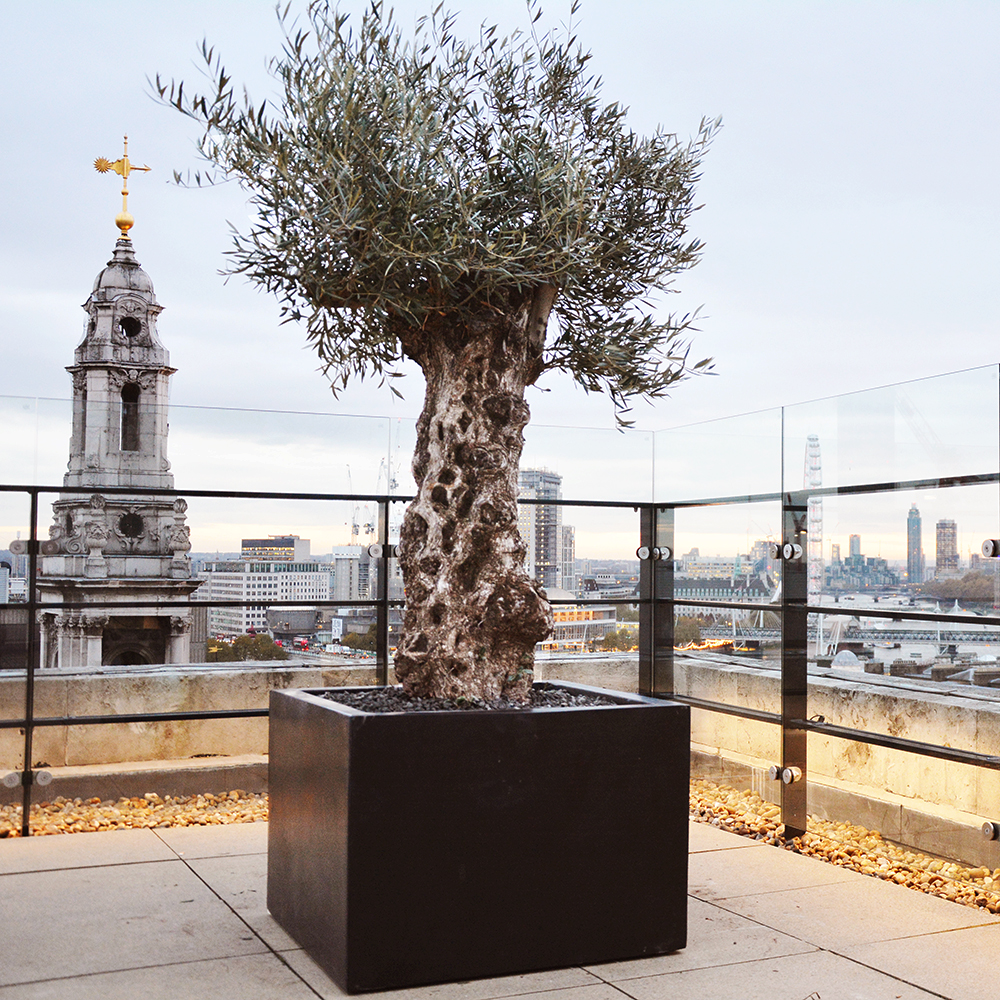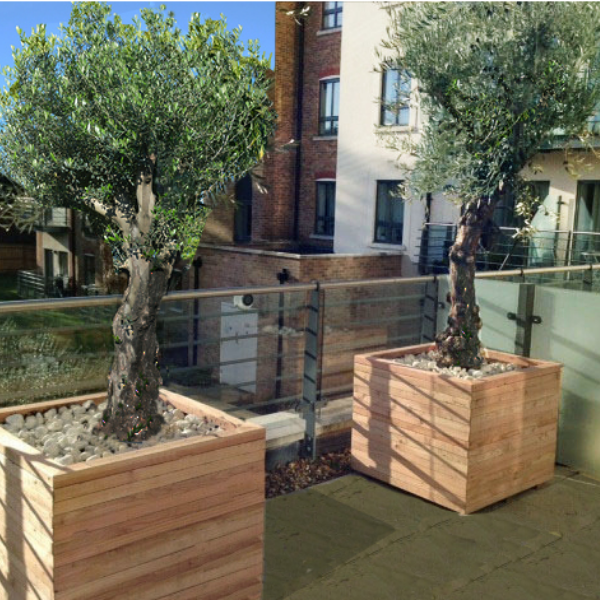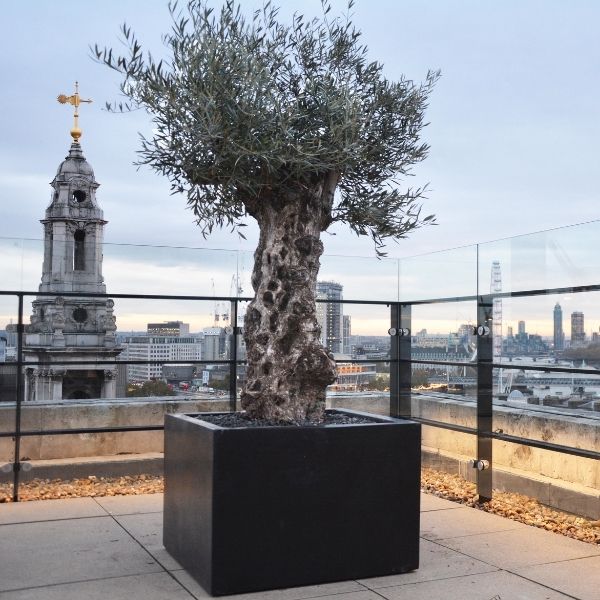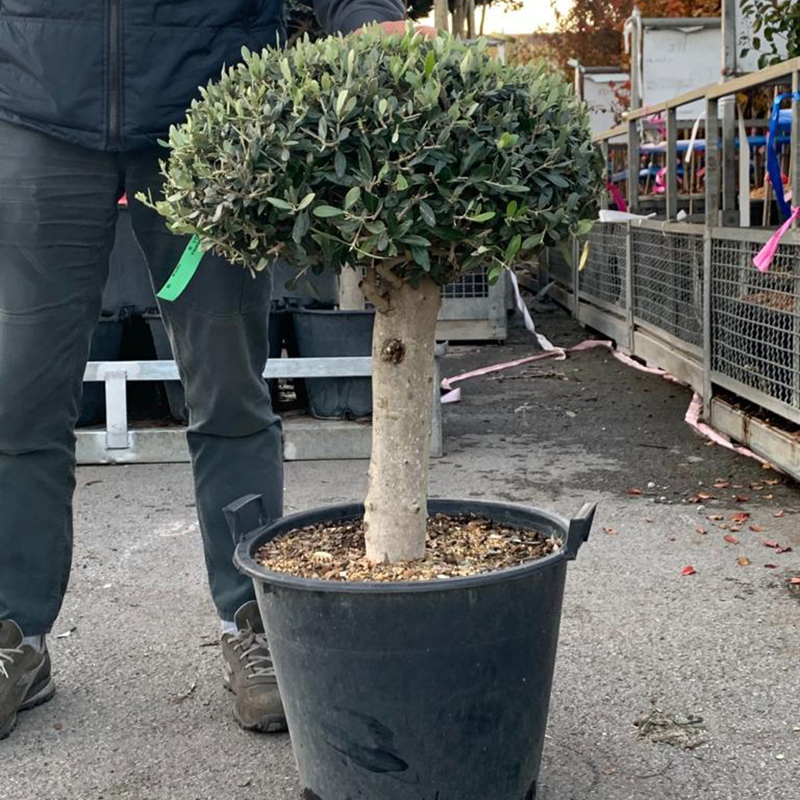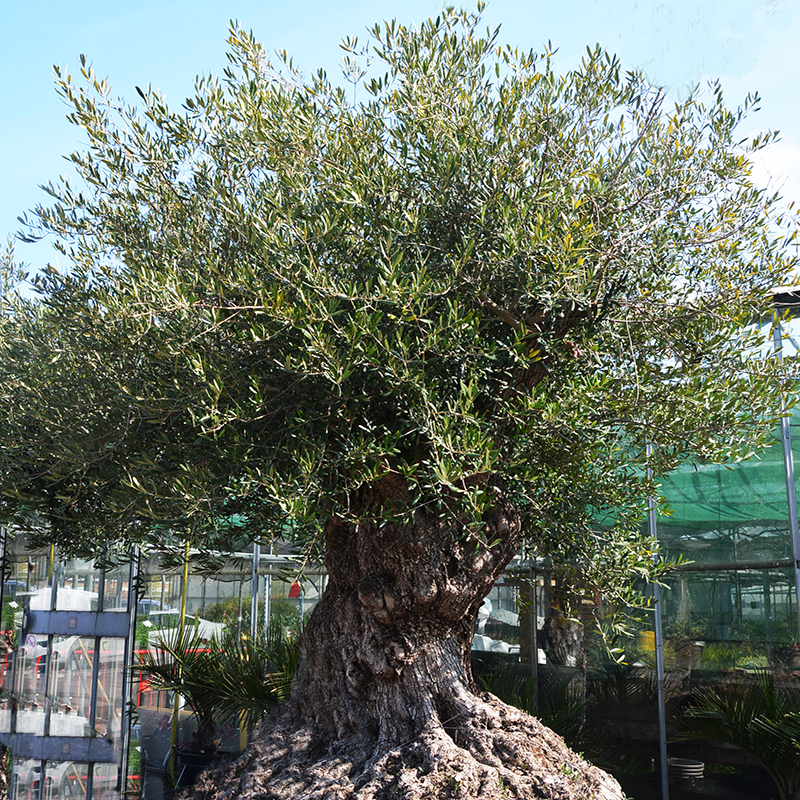Guide to planting and growing your olive trees
Choosing a Site
Position in the sunniest site possible, ideally south or west facing with some protection from the north and east winds.
Olives will tolerate some shade but want at least half a day of sun. Mild areas of the country, such as the South West and protected city gardens are the most suitable for growing olive trees, however, they can grow well in most areas with just a little bit of extra protection.
Place in an area of the garden that receives the most sun to allow the tree to get what it needs. South-facing walls are usually the best area of a garden.
An unheated conservatory or greenhouse should be considered for colder areas of the country. It is essential that your tree can get enough light and good ventillation.
Soil Conditions
Ensure planting soil is free-draining that will not become waterlogged during winter; olives are tolerant of both acidic and alkaline soils.
Poor sandy soils will benefit from the addition of soil improver or compost and clay soils may require additional grit.
Raised beds are an ideal way of raising the roots away from waterlogged soils.
Growing Olives in Planters, such as the Polystone planter shown here, allows you to produce the optimum soil conditions
See Below for other types of planters that we recommend
Pot Growing Trees
For most sites in the UK the best way to grow olive trees is to keep them in pots. This means that can be put outside in a sheltered location with lots of sun for most of the year and then moved to a more sheltered location in the winter time when temperatures start to cool below -10 degrees C.
Ensure that pots have good drainage holes and that the bottom of all containers are filled with some drainage crocks (pieces of broken terracotta pot). if you live in a cold area or a frost pocket line the inside of pots with bubble wrap or other insulating layer to protect roots from winter frost.
We recommend mixing one third john Innes no.3, one third of a good quality potting compost, one third horticultural grit. Never over-pot your olive tree and always re-pot just to a slightly larger container.
In the first 12 months, your tree will need to be re-potted into a larger container to give the roots more space to grow and to make sure the soil isn’t depleted of its nutrients.
Recommended Pots for Your Olive Tree
Terracotta or Larch wood is a preferable choice when growing olive trees in pots or containers. This is because they are more ‘breathable’ options and will help with drainage and insulation.
GRP / Fibreglass and Corten planters are also good options and have the benefit of being more lightweight and less prone to breakage.
Tips for Repotting
- Make sure the soil isn’t too wet when repotting, let it dry out slightly first
- Loosen the soil at the edges of the pot and pull the tree out by the base of the main stem
- Add a 5cm layer of clay pebbles at the bottom of the pot for improved drainage and aeriation of the roots (Click HERE for supplier)
- Add some extra soil into the bottom of the new pot before you insert the plant. We recommend John Innes number 3 for olives, with 10-20% added horticultural grit or perlite to improve drainage.
- Fill in around the plant with a mix of soil, compost and grit
- To allow the roots to bed in, keep the plant watered for several weeks.
- Alternatively, (and probably easier), If your tree is in a nursery container, turn it upside down and gently slide the tree out and separate the roots without overly disturbing the root ball. Place the tree in the new container and add more soil no deeper than it was in the original pot. Leave an inch between the soil and the rim of the container, so you’ll have room to water.
- Use a saucer underneath the container to catch any unwanted drips; allow space for easy drainage from the compost mix.
After the first repotting the tree should then be re-potted every few years until it reaches its final height. Over time, trees grown in pots deplete the nutrients in the potting soil making it important to either repot the plant or replace up to 50% of the compost every couple of years.
The best time to repot or plant your olive tree is in late spring but make sure to protect the tree in prolonged spells of cold. This allows the tree enough time to establish in its new home for the summer and create a hardier specimen for the winter.
How to Care for Your Olive Tree
Whatever the size or shape of your olive tree there are some basic care principles that apply to them all.
Watering
Lack of water is the main cause of olive poor growth, and the associated disease of the leaf, which inevitably occurs, as with any plant, if the plant continuously dries out. Most people associate olive trees with the hot Mediterranean and survive with little water. This is only because they are growing in the soil and have formed deep roots to find water. If pot grown olives suffer greatly if it allowed to dry out.
Water little and often. If the olive is planted in good draining compost, you cannot overwater it. If the area you live in has particularly sandy soil you may be required to water your tree more often as this type of soil is more porous and struggles to retain moisture.
Additional watering tips:
To ensure that the water gets into the root ball water at the base of the trunk, and thus avoid it overflowing down the sides of the pot, gently make six 1 cm diam x 2cm deep holes in a circle with a dibber in the rootball about 15-20cm away from the trunk, so that the water passes into the plant rootball. It is quite a good idea to dress the surface with decorative grit. The lighter coloured the better.
While olive varieties are drought tolerant and can go for long periods without water we wouldn’t recommend allowing the soil to become too dry. If the top inch of soil becomes dry, give the tree a nice deep watering and make sure the excess water can drain away.
While the olive tree requires regular watering, remember that olives are used to Mediterranean conditions and will not react well to wet feet or waterlogged soil. Make sure the pot can drain away and remember that underwatering in the short term is much less harmful than overwatering.
Over winter, reduce the watering. However, as they are evergreen the leaves are constantly losing water and the tree will suffer if the compost has completely dried out.
Feeding Olives
Feed your olive trees with ‘Miracle-Gro All Purpose Slow Release’ plant food in spring. If your plant has lost leaves in winter and you want to give it a boost, apply ‘Maxicrop Complete Garden Feed’ fortnightly between May and August to ensure the tree stays healthy, vigorous and happy. Click HERE for a supplier.
Pruning
Olive trees can be easily pruned to maintain the size and habit as required.
We recommend that light, formative pruning is undertaken in mid-spring with heavier trimming in early to mid-summer.
Never prune during the winter and be cautious in the autumn: Basically shape it as often as you like once spring has passed, until the end of October.

The purpose of trimming olive trees is to open more of the tree up to sunshine.
The parts of a tree that are in shade will not produce fruit. When you trim olive trees to allow sun to enter into the centre, it improves the fruiting. Read on for information about how to prune olive trees and the best time to prune olive trees.
Olives produce ‘suckers’ – growth of small shoots from the base of the trunk and up the trunk. These are best removed to encourage the plant to put its energy into the crown of the plant. Thinning the crown of the tree to avoid branches rubbing and making sure you can see daylight between branches will encourage healthy growth.
When it is time to shape the tree, remember that it is better to make a few, well-placed cuts than to make many small ones. You should use a lopper and a pruning saw to make these cuts.
Open-centre or vase pruning is very common with olive trees. For this type of pruning, you remove the tree’s central branches to allow sunlight to penetrate the tree. Open pruning also increases the surface fruiting area of the tree.
After you have removed central branches and established a sound structure for the tree, all subsequent pruning is for maintenance. At that point, trimming olive trees involves only removing any growth that starts to fill in the centre of the tree.
You can also keep down the height of the tree by pruning out the tallest branches. This is often important when you are pruning olive trees in containers. Use thinning cuts, not heading cuts, since the latter will stimulate new tall growth. Thinning cuts involve cutting something out, while heading cuts, also called topping cuts, involve cutting something off.
If you have a very tall, very old olive tree, you may have to prune it drastically to make it productive again, as well as to prevent it becoming too leggy.
Best Time to Prune Olive Trees
The best time is between winter’s end and flowering. You can prune olive trees in spring or in early summer once the tree begins to open its flower buds. Pruning an olive tree while it is in bloom allows you to assess the probable crop before you trim.
Always wait to trim until the rains of winter are done, since pruning opens entry points for water-borne disease to enter the tree. An olive tree is more vulnerable to frost damage once it is trimmed, which is another argument for waiting until spring.
Olive trees are slow growing and don’t need much attention when it comes to pruning, however, pinching some of the new growth will encourage the tree to send out more new shoots and in turn creating a bushier tree.
If you do decide that it is time to prune your olive tree make sure to remove any dead or diseased branches straight away. You can also remove any crossing branches within the tree and any leader branches that are making the tree look out of shape.
Pruning for shape should not really be done until the tree is at least 2-4 years old as the more leaves a young olive tree has, the more energy it will have to grow into a lovely, healthy specimen.
Over-pruning your olive tree can result in the tree producing lots of water shoots which will not produce fruits or flowers.
Winter Protection
Olive trees are hardy down to -10 degrees however they may require some overwinter protection.
Young plants and new shoots are especially susceptible to frost damage.
Growing your olive tree in a pot will allow you to move it around the garden to a more sheltered location in the winter if it is going to get particularly cold.
In areas where the minimum winter temperatures are between -2C and -5C, olive trees require no winter protection and will even tolerate drops down to -8C for short periods, providing the daytime temperature rises sufficiently.
In areas of lower winter temperatures, your olive tree can be protected with several layers of horticultural fleece wrapped around the trunk and crown of the tree.
Like many plants grown in pots, olive trees have not yet evolved to tolerate frozen roots; if this happens, they can suffer drought through not being able to take up water or worse still, the roots will be damaged which can result in subsequent poor growth or even death of the tree.
This can be prevented by adding several layers of bubble plastic to the inside of the pot when re-potting the plant or simply add layers of bubble plastic to the outside of the pot and secure with twine (not quite as attractive, but just as effective).
If you follow the advice given above, you will produce a very healthy olive tree, that will evoke a sense of the Mediterranean for many years ahead.
Fruit production
If the weather in your area is warm and mild enough your tree should start producing fruits at about 3-5 years old.
Olive trees should start to produce fruit when they reach around 3-5 years old, however, they require warm, mild weather and a lot of sun to produce a bumper crop of fruit. This is possible in the UK but for most olive trees this might just not happen.
For the olive trees to produce fruit they need a cold period of weather for 2 months.
Olives are self-fertile, and all plants are capable of setting fruit, as long as they experience a two month period of cold weather (below 10°C). Fruit will set on year old wood, and so over pruning will severely inhibit productivity.
If you are one of the lucky ones who’s olive tree manages to produce some fruit then you can harvest the fruits while they’re still green or you can wait until they turn dark purple. All green and black olives are the same, just in different stages of ripeness.
Curing your olives

Straight from the tree and the fruits are very bitter. They contain a chemical known as tannins which makes them unpleasant to eat raw. Olives eaten straight from the tree are bitter and unpleasant as they contain tannins. To make the fruits edible they require a curing process to break these down.
Your name *









